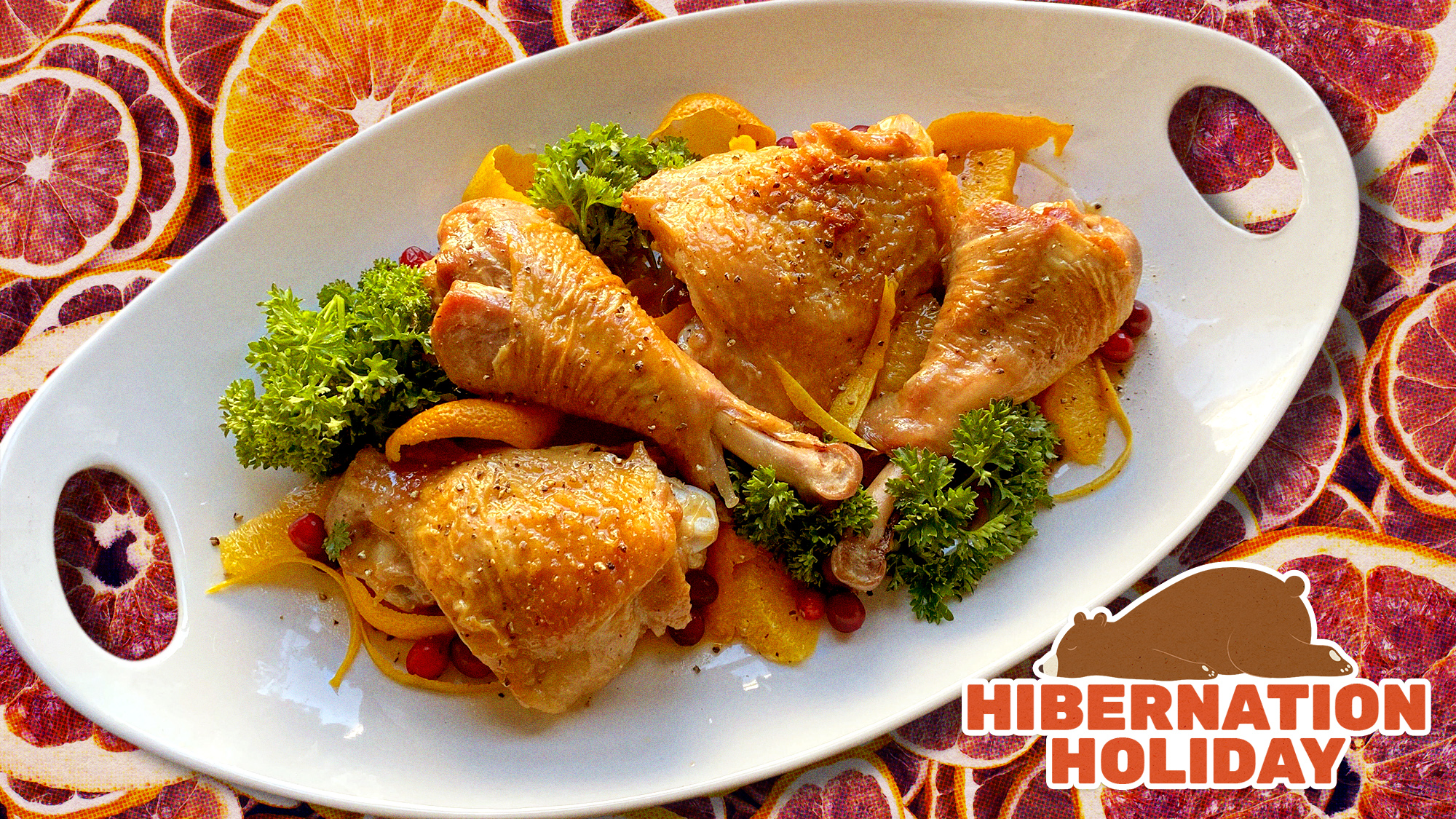Turkey à L'Orange Gives Dark Meat The Star Treatment
Your Thanksgiving bird has never looked this sophisticated.
Welcome to Hibernation Holiday, The Takeout's guide to celebrating Thanksgiving in the comfort of your own home—and in your sweatpants.
When I was little, I couldn't imagine a fancier meal than duck à l'orange. Back in the '80s the French still had total control over the whole fancy food racket, and since it would still be years before the advent of the Food Network, our cultural culinary education came from decades-old Julia Child reruns on PBS. In my mind you didn't just eat duck à l'orange because it tasted good; you did it to announce to the whole world that you're a very special person who deserves only the most exquisite of things. And aren't the holidays the perfect time to pretend you're the fanciest bastard on Earth? Thus, I give you turkey à l'orange.
Though you can adapt this recipe for any part of the turkey, I'm a dark meat devotee and chose to make this with the legs and thighs of my broken-down bird. If you're not cutting up your own turkey for parts (which is 110% fine), you can buy pre-cut turkey sections, and if you can't find thighs (why don't more places sell turkey thighs?), go for an all-leg l'orange experience.
To make it a bit more magnifique, I decided to slather some duck fat under the turkey skin. Once a specialty ingredient, it's surprisingly easy to find now—I've seen jars of duck fat at Walmart, which is something I never thought I'd be typing. If you'd rather not use it, you can use softened butter, or skip this step entirely; if you do rub anything under the turkey skin, make sure you use toothpicks to hold the skin in place, otherwise it'll separate and curl up while roasting. And please, do present your turkey à l'orange with vibrant green tufts of curly parsley, because that's a garnish that needs to make a comeback. It gives you "vintage" elegance for less than a buck, and making yourself feel like a 20th-century sophisticate is worth the pocket change.

Dark Meat Turkey à L’Orange
- 6 turkey legs, or 2 legs and 2 thighs
- Duck fat (optional)
For the sauce, part one:
- 1/4 cup duck fat or butter
- 1 medium carrot, chopped
- 1 large celery stalk, chopped
- 1 onion, chopped
- 4 cloves garlic, crushed
- 2 Tbsp. tomato paste
- 4 cups chicken or turkey stock
- 1/2 cup white wine
- 4 sprigs fresh thyme
- 2 bay leaves
For the sauce, part two:
- 3 large navel oranges
- 1/2 cup cider vinegar
- 1/3 cup sugar
- 1/4 can (3.5 oz.) jellied cranberry sauce, well smooshed with a fork
- 2 Tbsp. butter, cut into pieces
- 2 Tbsp. Grand Marnier, Triple Sec, or Curacao (optional)
- Curly parsley and fresh cranberries, for garnish
First, start the sauce
Melt the duck fat or butter in a heavy-bottomed saucepan over high heat, then add the chopped carrots, celery, and onion with a hefty pinch of kosher salt. Cook over high heat, stirring occasionally, until the vegetables soften (about 5 minutes), then lower the heat to medium, add the garlic, and cook for about 5 minutes more until everything turns a rich, caramelized brown. Stir in the tomato paste and cook for another minute, then add the chicken stock, white wine, thyme, and bay leaves. Turn the heat to high until the pot boils, then drop to medium-low and simmer for an hour. Strain the sauce, discarding the solids; measure the amount of sauce you end up with, then pour back into the pan and reduce it over high heat until you end up with 2 cups.
While the sauce simmers, start the turkey
Preheat the oven to 450 degrees Fahrenheit. If desired, gently separate the skin from the turkey, then smear a bit of softened duck fat directly on the meat with a small pinch of kosher salt. Pull the skin back over the turkey and use toothpicks to secure it to the meat—otherwise, it will separate and curl up while roasting. Pat the meat dry with paper towels, sprinkle generously with salt and pepper, then place on a rack in a roasting pan. Roast the turkey for 25-35 minutes, until a thermometer stuck into the fattest part of the meat registers around 160 degrees Fahrenheit. Turn off the oven and leave it open while the turkey rests for 5 minutes, then use it to keep the turkey warm while you finish the sauce.
The sauce: phase two
Using a vegetable peeler, cut thick strips of peel from the oranges, making sure you don't include any of the white pith. Put into a small saucepan, cover with 1" of water, bring to a boil, then strain and set the blanched peels aside. Juice two of the oranges (you should have about 3/4 cup juice), then supreme the third orange and set aside.
Combine the vinegar and sugar together in a small saucepan and cook over high heat for 3-4 minutes until it caramelizes into a medium shade of amber. Pour in the orange juice, the strained sauce from step one, and the jellied cranberry sauce, and bring to a boil. Reduce heat to low and simmer for about 10 minutes. Remove from heat, add the butter and orange liqueur (if using), then use an immersion blender to puree until smooth. Taste for seasoning, adding salt and pepper as needed.
Plate and serve
Toss the roast turkey in the sauce, put on a platter, and pour the remaining sauce on top. Garnish with the blanched orange peel and supremed orange sections, then add some curly parsley and fresh cranberries for a bit of color. Serve immediately.
